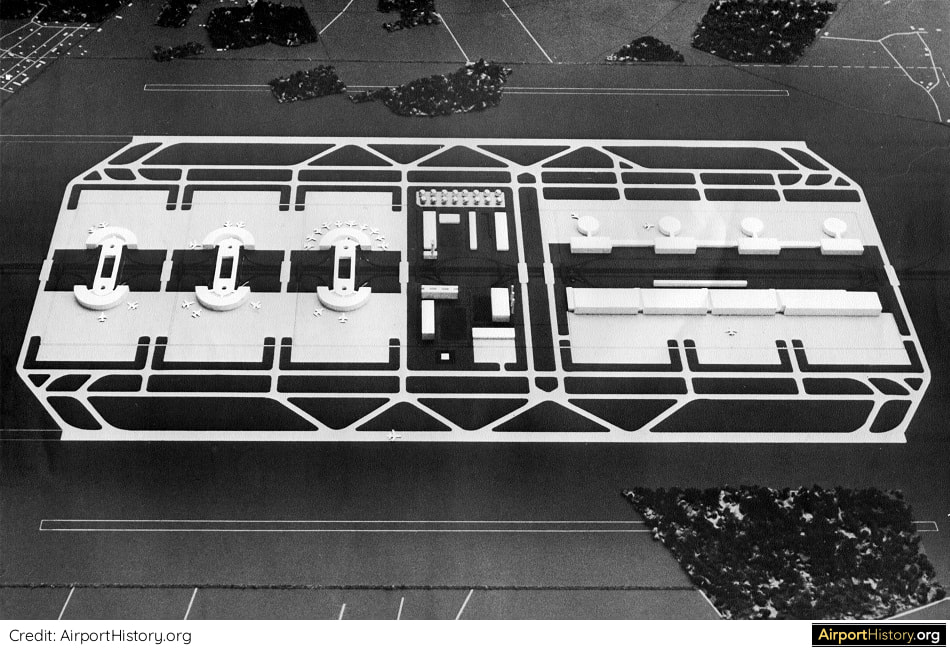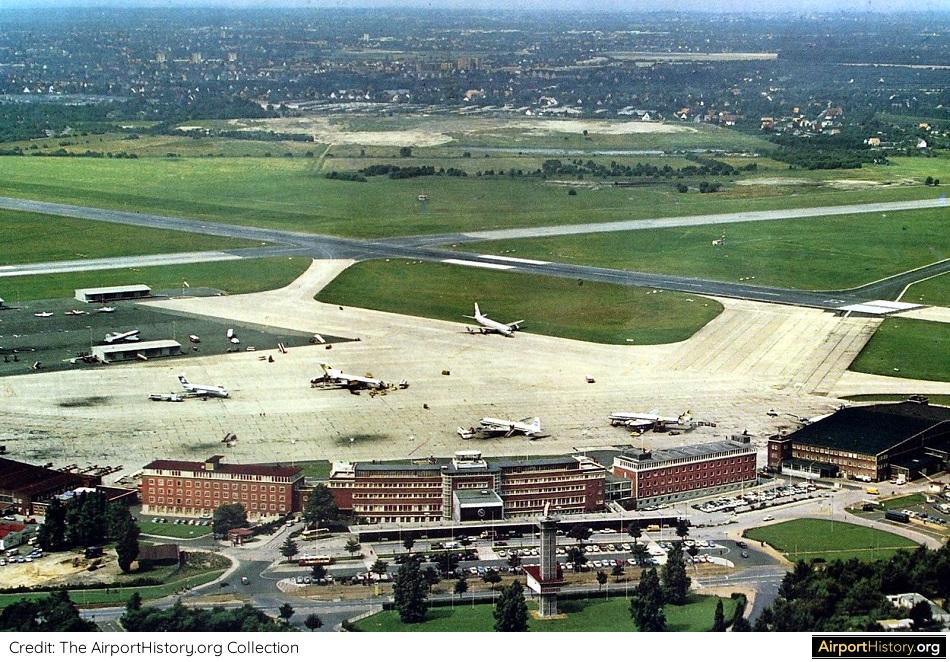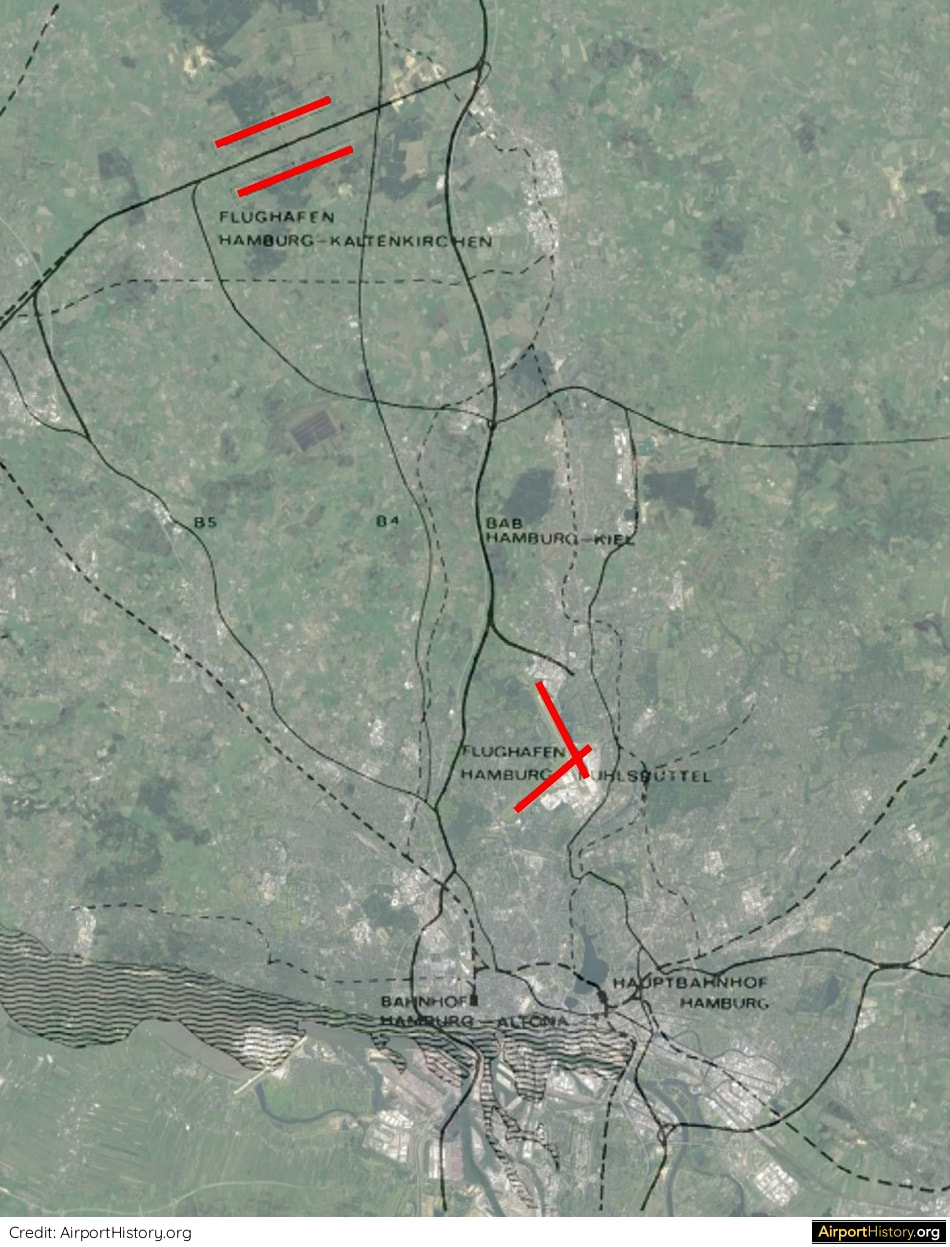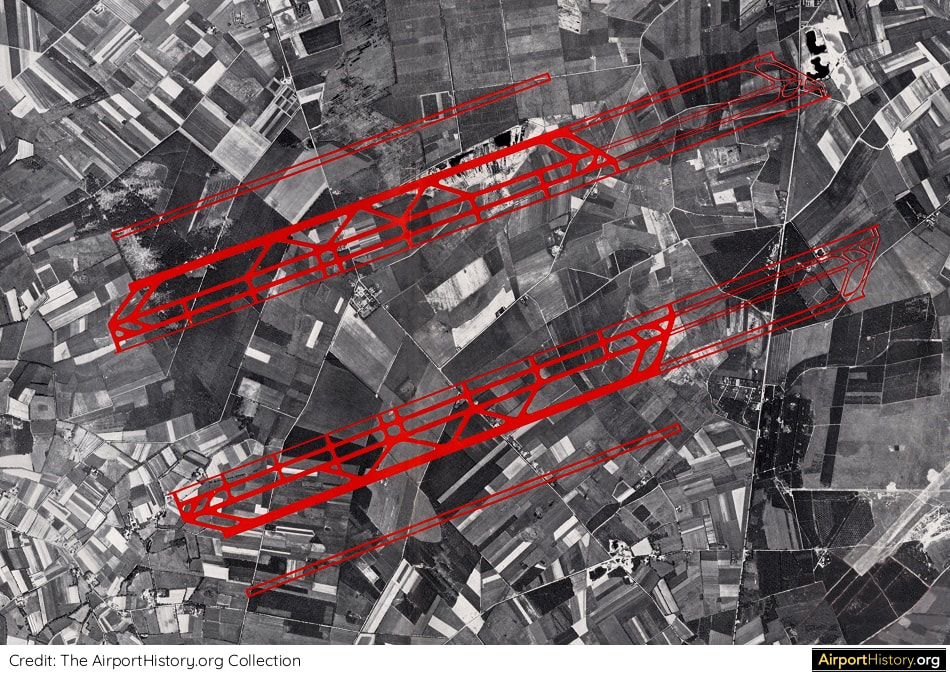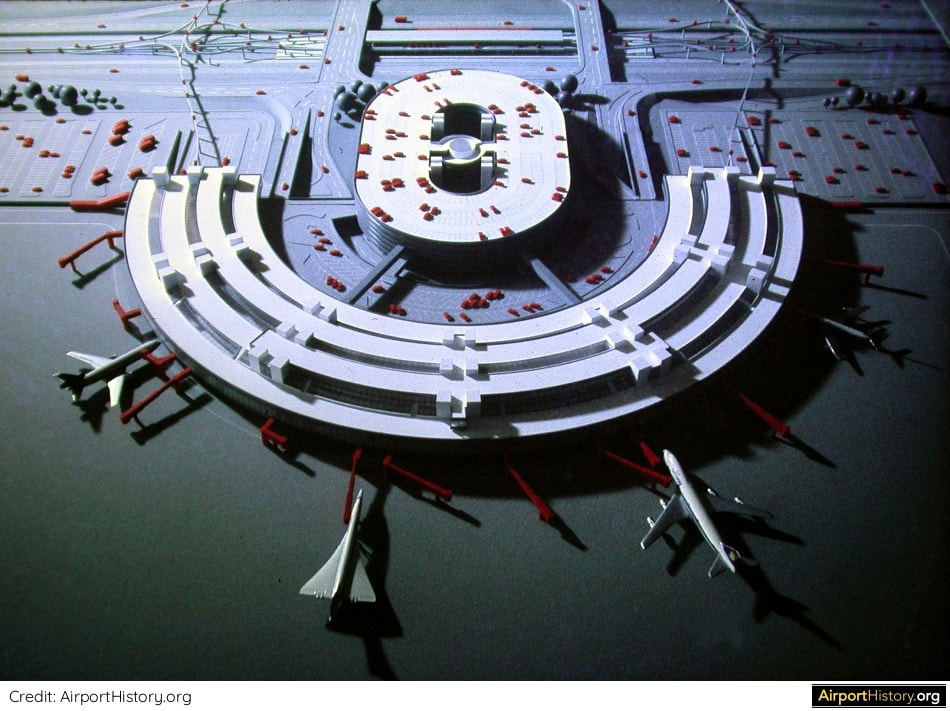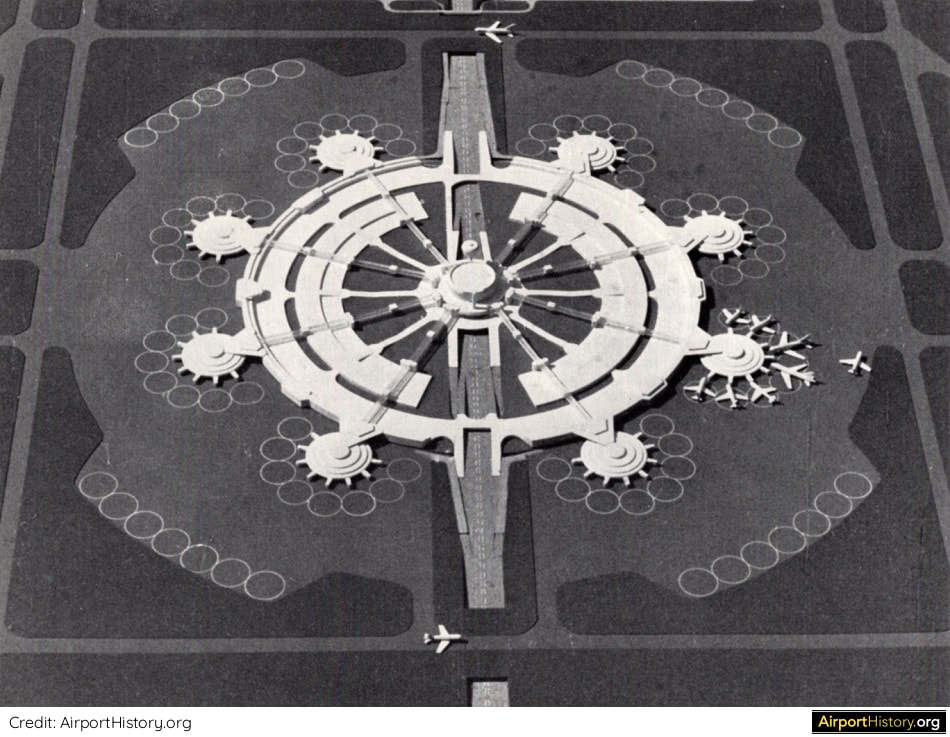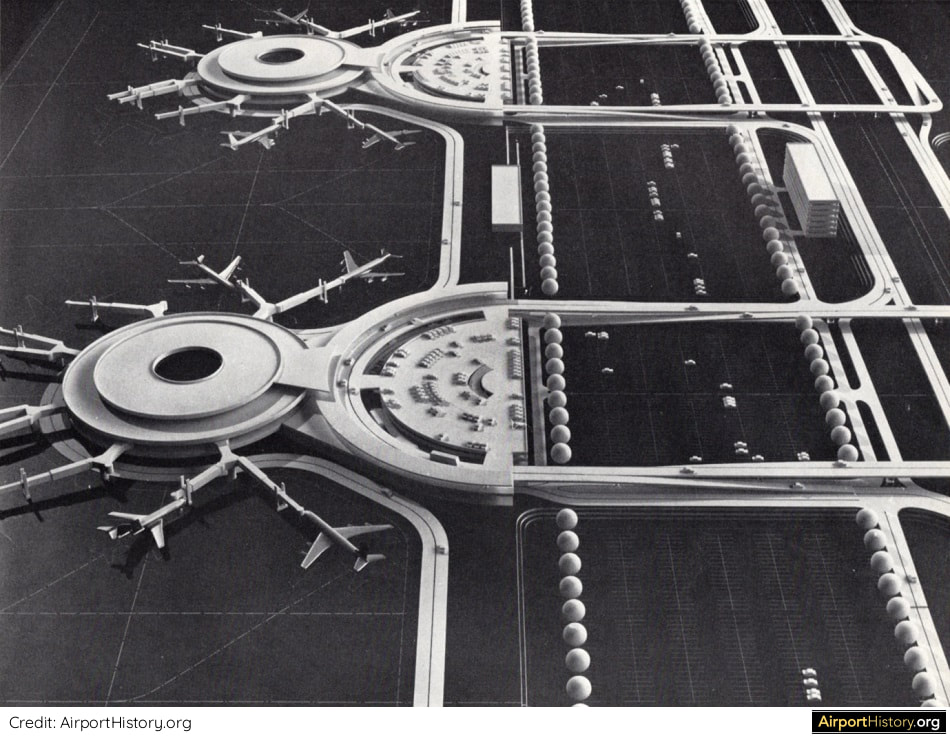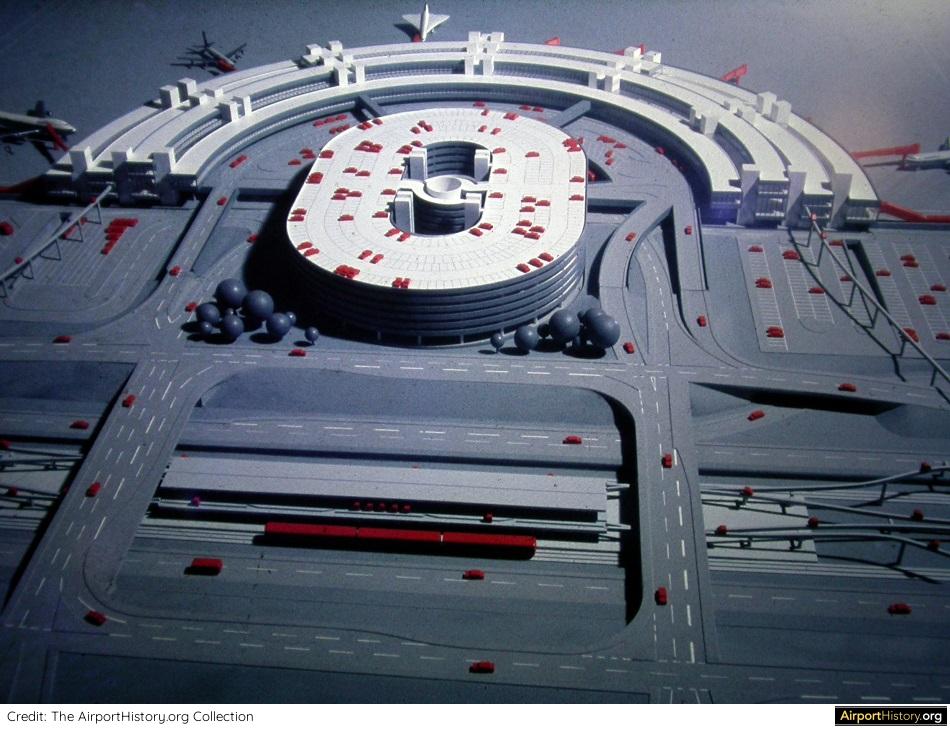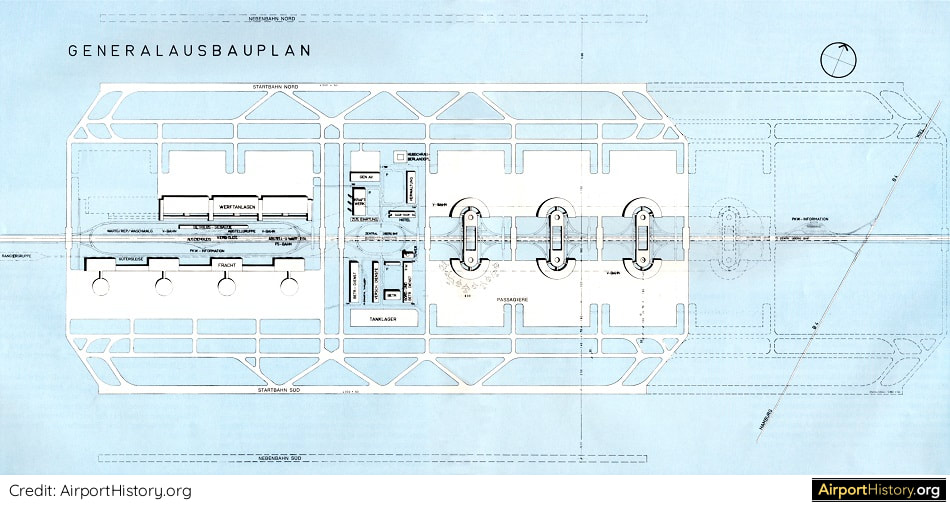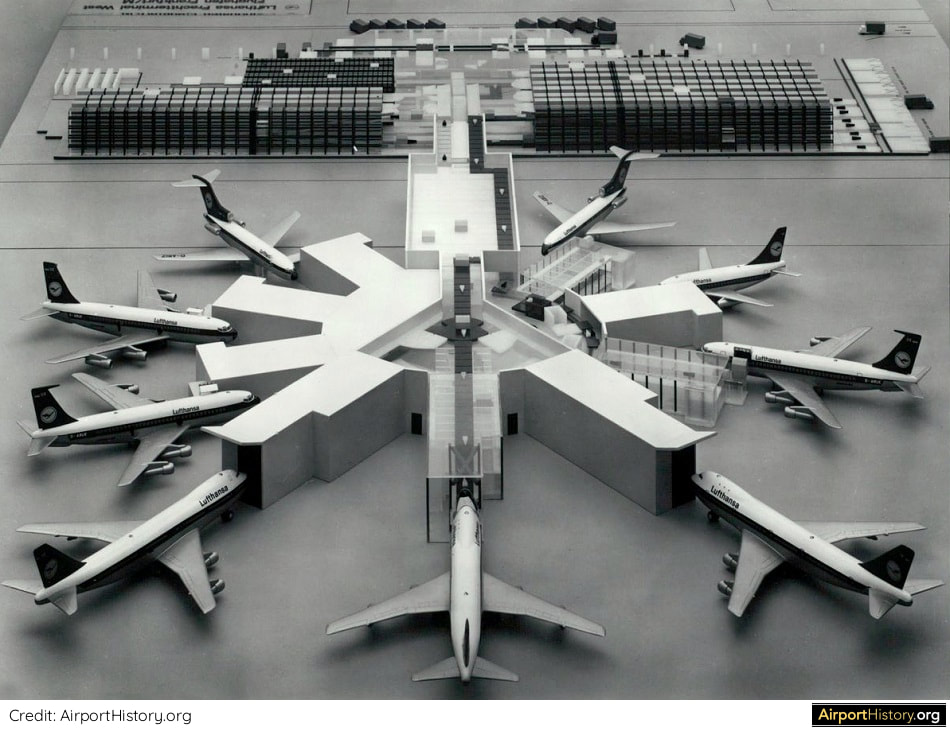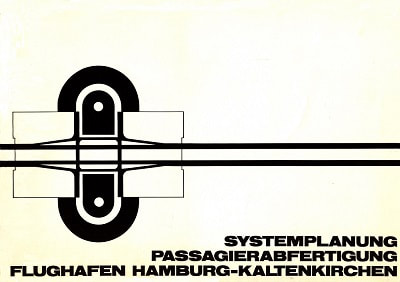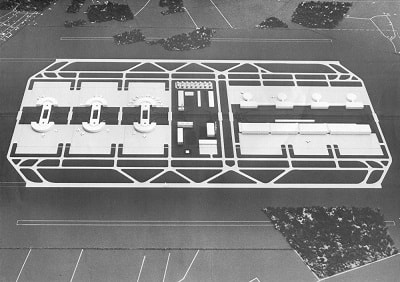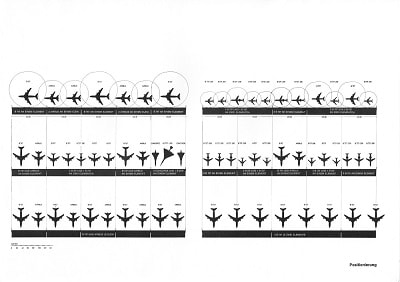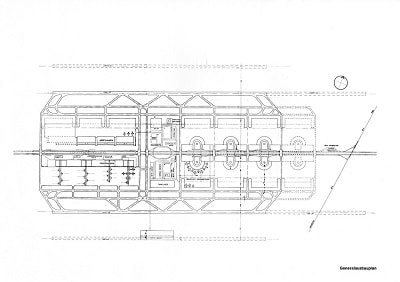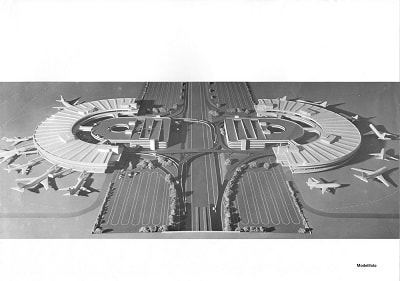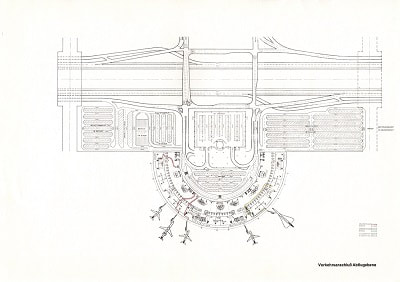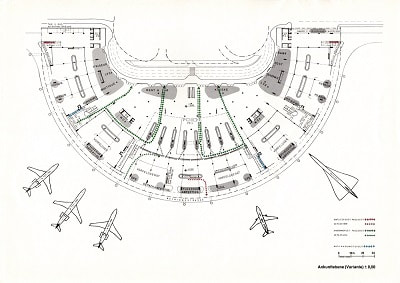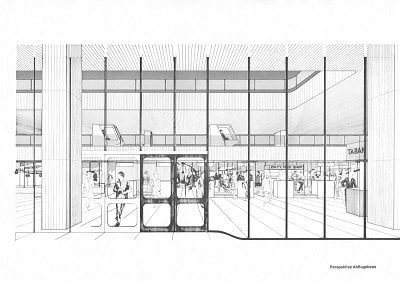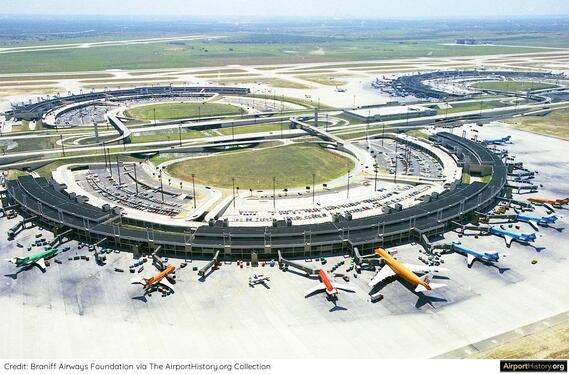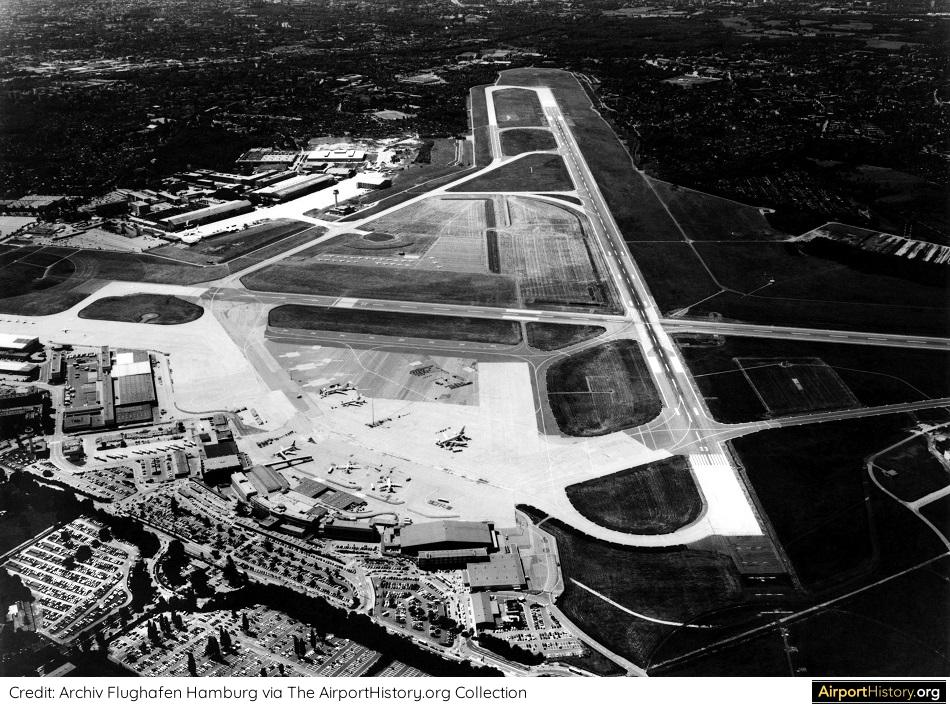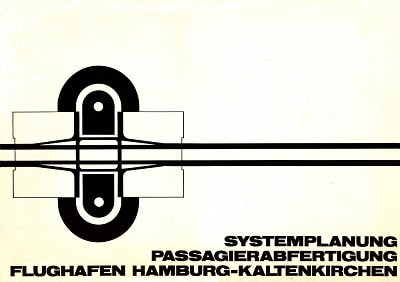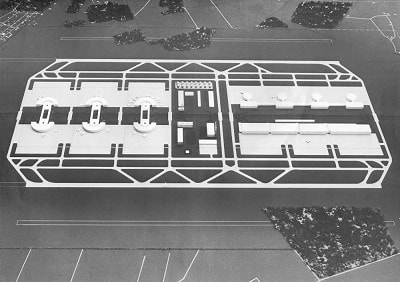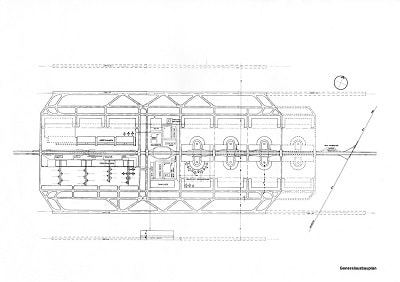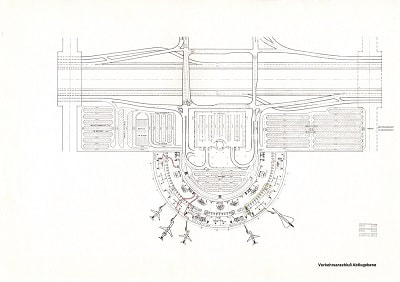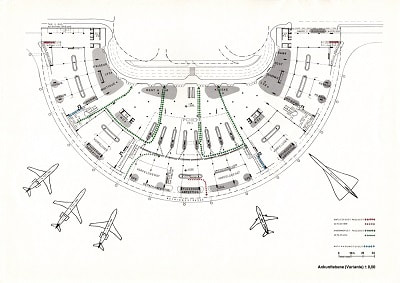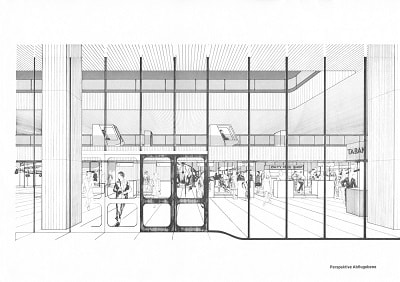Published: December 4, 2019
Updated: February 25, 2022
Updated: February 25, 2022
With four parallel runways and up to eight passenger terminals, Hamburg Kaltenkirchen Airport would have been one of the largest airports in Europe and in the world. Learn all about this never-built mega airport, whose terminals bore more than a passing resemblance to those at Dallas/Fort Worth!
Hamburg Kaltenkirchen: The DFW of Europe
THE NEED FOR A NEW AIRPORT
Hamburg is a wealthy and vibrant port city, located in the north of Germany. It is Germany's second largest city by population, after Berlin.
During the decades following World War II, Hamburg's economy and population boomed. In the period between 1950 and 1961, its population grew by 15% to 1.8 million people. It was projected that in the ensuing decades, the number of inhabitants would swell by another 20% to 2.2 million inhabitants.
As a result, passenger traffic at the Hamburg Fuhlsbüttel Airport was growing rapidly. In 1962, the airport handled over a million passengers, making it the third busiest airport behind Frankfurt Rhein Main and Berlin Tempelhof.
At the time, Fuhlsbüttel was Lufthansa's second largest base after Frankfurt--it even had been Lufthansa's main base for a number of years after the establishment of post-war Lufthansa in 1955. Due to this historic presence, the carrier operated its largest maintenance facilities at Fuhlsbüttel.
Hamburg is a wealthy and vibrant port city, located in the north of Germany. It is Germany's second largest city by population, after Berlin.
During the decades following World War II, Hamburg's economy and population boomed. In the period between 1950 and 1961, its population grew by 15% to 1.8 million people. It was projected that in the ensuing decades, the number of inhabitants would swell by another 20% to 2.2 million inhabitants.
As a result, passenger traffic at the Hamburg Fuhlsbüttel Airport was growing rapidly. In 1962, the airport handled over a million passengers, making it the third busiest airport behind Frankfurt Rhein Main and Berlin Tempelhof.
At the time, Fuhlsbüttel was Lufthansa's second largest base after Frankfurt--it even had been Lufthansa's main base for a number of years after the establishment of post-war Lufthansa in 1955. Due to this historic presence, the carrier operated its largest maintenance facilities at Fuhlsbüttel.
LIMITED CAPACITY
Fuhlsbüttel Airport had two intersecting runways, limiting its capacity to about 45 takeoffs and landings per hour. The airport's convenient location close to the city meant that building a new runway would be very expensive and controversial. If Hamburg wanted to retain its strategic advantage, something had to be done.
Fuhlsbüttel Airport had two intersecting runways, limiting its capacity to about 45 takeoffs and landings per hour. The airport's convenient location close to the city meant that building a new runway would be very expensive and controversial. If Hamburg wanted to retain its strategic advantage, something had to be done.
Kaltenkirchen was to develop into a major international hub serving northern Germany.
|
KALTENKIRCHEN
In October 1960, an expert committee started looking into the feasibility of building a new airport. Four locations in the vicinity of Hamburg were considered. A year later, the decision was taken to locate the new airport just west of the town of Kaltenkirchen, which would give its name to the new airport. The site was only 22 miles (35 kilometers) north of downtown Hamburg and well located relative to other cities within the state of Schleswig-Holstein, such as Kiel and Lübeck. At the same time, the area was relatively thinly populated and thus aircraft noise--a new and growing concern in the early Jet Age--would be minimal. In 1963, authorities started buying land. A total area of 5500 acres (2200 hectares) was purchased at a cost of USD 46 million. In 1965, state authorities granted planning permission for the project. |
THE AMBITIONS
In 1968, planning experts started work on the airport. The ambitions were high. Kaltenkirchen was to develop into a major international hub serving northern Germany.
The airport had to be able to handle the new generation of upcoming wide-body jets and supersonic aircraft such as the Concorde and the Boeing 2707. The airport needed to be expandable so that it could grow along with demand. Lastly, the plan needed the flexibility to adjust to the then unknown demands of the future.
In 1968, planning experts started work on the airport. The ambitions were high. Kaltenkirchen was to develop into a major international hub serving northern Germany.
The airport had to be able to handle the new generation of upcoming wide-body jets and supersonic aircraft such as the Concorde and the Boeing 2707. The airport needed to be expandable so that it could grow along with demand. Lastly, the plan needed the flexibility to adjust to the then unknown demands of the future.
TWO AIRPORTS
Interestingly, Fuhlsbüttel was to be maintained as a commercial airport after Kaltenkirchen opened. The airport's convenient downtown location was considered a great asset to the business community. Another important reason was that Lufthansa had a large maintenance complex at Fuhlsbüttel, which the airline did not want to give up.
The idea was that Fuhlsbüttel's traffic would be fixed at around 3 million passengers annually and that it would focus on European destinations, while Kaltenkirchen would focus on long-haul traffic.
Nowadays, splitting (short- and medium haul) traffic would be seen as bad decision as this limits the possibilities to create convenient transfer connections for the airline(s). However, this was years before the hub-and-spoke concept came into existence, even though Lufthansa already connected plenty of passengers at Frankfurt at the time.
Interestingly, Fuhlsbüttel was to be maintained as a commercial airport after Kaltenkirchen opened. The airport's convenient downtown location was considered a great asset to the business community. Another important reason was that Lufthansa had a large maintenance complex at Fuhlsbüttel, which the airline did not want to give up.
The idea was that Fuhlsbüttel's traffic would be fixed at around 3 million passengers annually and that it would focus on European destinations, while Kaltenkirchen would focus on long-haul traffic.
Nowadays, splitting (short- and medium haul) traffic would be seen as bad decision as this limits the possibilities to create convenient transfer connections for the airline(s). However, this was years before the hub-and-spoke concept came into existence, even though Lufthansa already connected plenty of passengers at Frankfurt at the time.
A scalable mega airport
FOUR RUNWAYS
The Kaltenkirchen Master Plan proposed an airport with two 13,000-foot (4,000-meter) parallel runways laid out in an east-west direction. If needed, the runways could be extended to an astonishing 19,291 feet (5,880 meters)!
Two more runways could be added in the future, providing a total of four parallel runways and an hourly capacity of 120 aicraft movements per hour. In Europe today, only Paris de Gaulle Airport could have matched Kaltenkirchen's runway capacity.
The Kaltenkirchen Master Plan proposed an airport with two 13,000-foot (4,000-meter) parallel runways laid out in an east-west direction. If needed, the runways could be extended to an astonishing 19,291 feet (5,880 meters)!
Two more runways could be added in the future, providing a total of four parallel runways and an hourly capacity of 120 aicraft movements per hour. In Europe today, only Paris de Gaulle Airport could have matched Kaltenkirchen's runway capacity.
SEMI-CIRCULAR PASSENGERS TERMINALS
In 1968, three consortia were asked to design different concepts for the passenger terminal. The chosen design, submitted by the consortium of Dorsch, Gerlach, Freese, Weidle, and Howell, envisaged the construction of a series of semi-circular passenger passenger terminals, quite similar to those found at DFW.
The main advantage of the concept was that it minimized the distance between the curbside and the gate. In the United States, this was referred to as the "drive-to-the-gate" concept.
One terminal would boast 15 gates served by passenger boarding bridge and could accomodate 10 large aircraft or 15 middle-size aircraft. The handling capacity was 2200 passenger per hour or about 4-5 million passengers annually.
In 1968, three consortia were asked to design different concepts for the passenger terminal. The chosen design, submitted by the consortium of Dorsch, Gerlach, Freese, Weidle, and Howell, envisaged the construction of a series of semi-circular passenger passenger terminals, quite similar to those found at DFW.
The main advantage of the concept was that it minimized the distance between the curbside and the gate. In the United States, this was referred to as the "drive-to-the-gate" concept.
One terminal would boast 15 gates served by passenger boarding bridge and could accomodate 10 large aircraft or 15 middle-size aircraft. The handling capacity was 2200 passenger per hour or about 4-5 million passengers annually.
GALLERY: TERMINAL DESIGN CONCEPTS (CLICK TO ENLARGE)
FLEXIBLE GROWTH
Additional modules could be added as traffic grew. The master plan envisaged a total of six passenger terminals, together providing up to 80 close contact stands served by passenger boarding bridge, as well as 40 remote stands. The plan contained a strategic reservation for the construction of a seventh and eighth passenger terminal.
It was assumed that between 20% and 30% of passengers would need to transfer between flights. Thus, the terminals were to be connected by means of small Automated People Mover (APM) vehicles, each carrying up to four people, and running on an intricate system of tracks traversing the airport. The APM would also connect to the airport train station(s).
The eight passenger terminals together would generate capacity of 40 million passengers annually, a number that arguably could be much higher based on current understanding of capacity and the use modern technologies.
Additional modules could be added as traffic grew. The master plan envisaged a total of six passenger terminals, together providing up to 80 close contact stands served by passenger boarding bridge, as well as 40 remote stands. The plan contained a strategic reservation for the construction of a seventh and eighth passenger terminal.
It was assumed that between 20% and 30% of passengers would need to transfer between flights. Thus, the terminals were to be connected by means of small Automated People Mover (APM) vehicles, each carrying up to four people, and running on an intricate system of tracks traversing the airport. The APM would also connect to the airport train station(s).
The eight passenger terminals together would generate capacity of 40 million passengers annually, a number that arguably could be much higher based on current understanding of capacity and the use modern technologies.
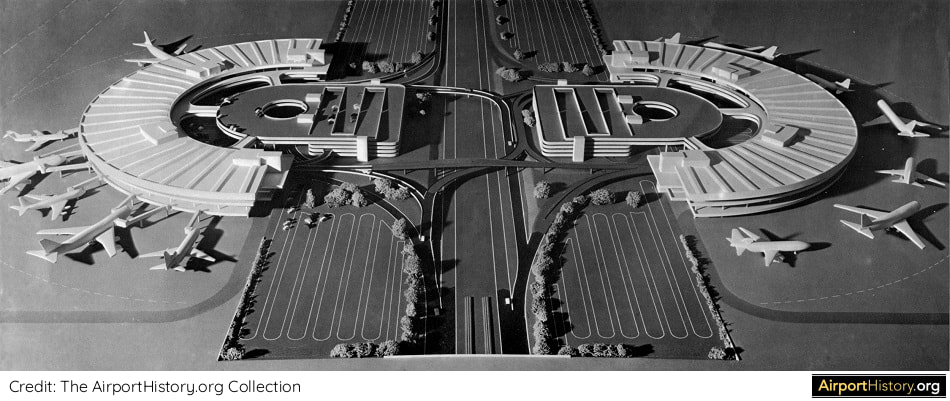
A model showing two passenger terminal modules. The plan allowed for a total of eight modules to be built. Despite the intricate automated people mover system connecting the terminals, this layout would certainly not have been ideal for passengers connecting between flights, but this was not a planning consideration in the days before the hub-and-spoke concept.
Kaltenkicrchen was scheduled to open in 1975, the year that downtown Fuhlsbüttel Airport was expected to reach its ultimate capacity.
SPINE ROAD
The airport was the to be bisected by a spine road, a popular airport planning concept at the time. Spineroads were also used at airports such as Dallas-Fort Worth, Montreal Mirabel, and Paris de Gaulle, which were then under development.
The passenger terminals, cargo, maintenance, and support facilities, were laid out on both sides of the spine road, which would connect to the A7 Autobahn to Hamburg. A rail connection connecting the airport to downtown Hamburg was also planned.
The airport was the to be bisected by a spine road, a popular airport planning concept at the time. Spineroads were also used at airports such as Dallas-Fort Worth, Montreal Mirabel, and Paris de Gaulle, which were then under development.
The passenger terminals, cargo, maintenance, and support facilities, were laid out on both sides of the spine road, which would connect to the A7 Autobahn to Hamburg. A rail connection connecting the airport to downtown Hamburg was also planned.
|
OTHER FACILITIES
The western side of the airport would boast a massive cargo zone consisting of four state-of-the-art cargo terminals, which together could process 3 million tonnes of cargo annually. Very advanced for the time, the cargo area would have its own railway station to enable rail-to-air transfer of cargo. The opposite side of the spineroad featured a large aircraft maintentance and repair area, the idea likely being that Lufthansa would move its MRO activities from Fuhlsbüttel to Kaltenkirchen at some point in the future. |
The centre area of the airport accomodated the railway station, the air traffic control tower, hotels, various office buildings, the fuel farm, the power plant, general aviation facilities, and a heliport.
INITIAL DEVELOPMENT
The first-phase development would include the southern runway, a parallel taxiway and exits, a single semi-circular terminal module, a cargo terminal, and support facilities. The total investment for Phase 1 would be an estimated USD 230 million dollars.
INITIAL DEVELOPMENT
The first-phase development would include the southern runway, a parallel taxiway and exits, a single semi-circular terminal module, a cargo terminal, and support facilities. The total investment for Phase 1 would be an estimated USD 230 million dollars.
Add the Kaltenkirchen Master Plan to your airport collection!
Click the images below to purchase a high-quality digitized copy of this visionairy 56-page plan, a must-have for airport history fans!
Or you can make a simple donation.
Your support will help our mission to protect the heritage of the world’s airports!
Click below to support.
A DFW look-alike?
The design was quite similar to that of Dallas/Fort Worth Airport, which was being planned around the same time. Both made use of the concept of semi-circular terminals built on opposite sides of a spine road. Furthermore, both airports made use of a automated people mover (APM) system to connect passengers between the terminals.
But there were major differences too: DFW's terminals were longer and provided more close contact gates than those of Kaltenkirchen's (20 vs. 15). However, Kaltenkirchen's terminals boasted two levels instead one, separating departing and arriving traffic.
This made sense, as in the pre-Schengen days most flights were international rather than domestic, requiring a separation of levels. Kaltenkirchen's terminals were also wider, presumably to create more space for functions such as security, customs and border control.
Another difference was the sheer scale of the plans. The DFW master plan foresaw the construction of 13 semi-circular terminals and seven runways, as opposed to Kaltenkirchen's eight terminals and four runways.
But there were major differences too: DFW's terminals were longer and provided more close contact gates than those of Kaltenkirchen's (20 vs. 15). However, Kaltenkirchen's terminals boasted two levels instead one, separating departing and arriving traffic.
This made sense, as in the pre-Schengen days most flights were international rather than domestic, requiring a separation of levels. Kaltenkirchen's terminals were also wider, presumably to create more space for functions such as security, customs and border control.
Another difference was the sheer scale of the plans. The DFW master plan foresaw the construction of 13 semi-circular terminals and seven runways, as opposed to Kaltenkirchen's eight terminals and four runways.
Enjoying this article?
Sign up to our e-mail newsletter to know when new content goes online!
Delays and cancellation
LOCAL OPPOSITION
The airport was scheduled to open in 1975, the year that downtown Fuhlsbüttel was projected to reach its ultimate capacity of 5 million annual passengers. However, due to local opposition and slower than expected traffic growth, the project timetable kept slipping.
Final approval for the project finally came in 1977, but due to fierce opposition, the approval was revoked in 1980. After that, the project slowly disappeared off the political agenda. Finally, it was decided to expand Fuhlsbüttel instead. Interestingly, Hamburg Airport management didn't sell the land, even increasing its land holdings.
The airport was scheduled to open in 1975, the year that downtown Fuhlsbüttel was projected to reach its ultimate capacity of 5 million annual passengers. However, due to local opposition and slower than expected traffic growth, the project timetable kept slipping.
Final approval for the project finally came in 1977, but due to fierce opposition, the approval was revoked in 1980. After that, the project slowly disappeared off the political agenda. Finally, it was decided to expand Fuhlsbüttel instead. Interestingly, Hamburg Airport management didn't sell the land, even increasing its land holdings.
CANCELLATION
In the ensuing decades, the discussion about Kaltenkirchen flared up from time to time, with the last serious debate dating back to 2003. In 2013, it was decided to bury the project permanently. Subsequently, one of the shareholders of the project, the city of Kiel, sold off its part of the land for commercial and residential development.
In 2019, Hamburg Helmut Schmidt Airport, as it is now officially called, handled over 17 million passengers, making it the fifth busiest airport in Germany, behind Frankfurt, Munich, Düsseldorf and Berlin Tegel.
Although Lufthansa's subsidiary Eurowings maintains a major presence at Hamburg, it pales in comparison to Lufthansa's hub operations at Frankfurt and Munich.
In the ensuing decades, the discussion about Kaltenkirchen flared up from time to time, with the last serious debate dating back to 2003. In 2013, it was decided to bury the project permanently. Subsequently, one of the shareholders of the project, the city of Kiel, sold off its part of the land for commercial and residential development.
In 2019, Hamburg Helmut Schmidt Airport, as it is now officially called, handled over 17 million passengers, making it the fifth busiest airport in Germany, behind Frankfurt, Munich, Düsseldorf and Berlin Tegel.
Although Lufthansa's subsidiary Eurowings maintains a major presence at Hamburg, it pales in comparison to Lufthansa's hub operations at Frankfurt and Munich.
What would have happened if Kaltenkirchen had opened in 1975 as planned?
The airport would have opened many years before the new Munich Airport, which opened in 1992. Could Kaltenkirchen have become Lufthansa's second hub instead of Munich?
What do you think? Let us know your thoughts on the Kaltenkirchen project below in the comments!
The airport would have opened many years before the new Munich Airport, which opened in 1992. Could Kaltenkirchen have become Lufthansa's second hub instead of Munich?
What do you think? Let us know your thoughts on the Kaltenkirchen project below in the comments!
Add the Kaltenkirchen Master Plan to your airport collection!
Click the images below to purchase a high-quality digitized copy of this visionairy 56-page plan, a must-have for airport history fans!
Or you can make a simple donation.
Your support will help our mission to protect the heritage of the world’s airports!
Click below to support.

